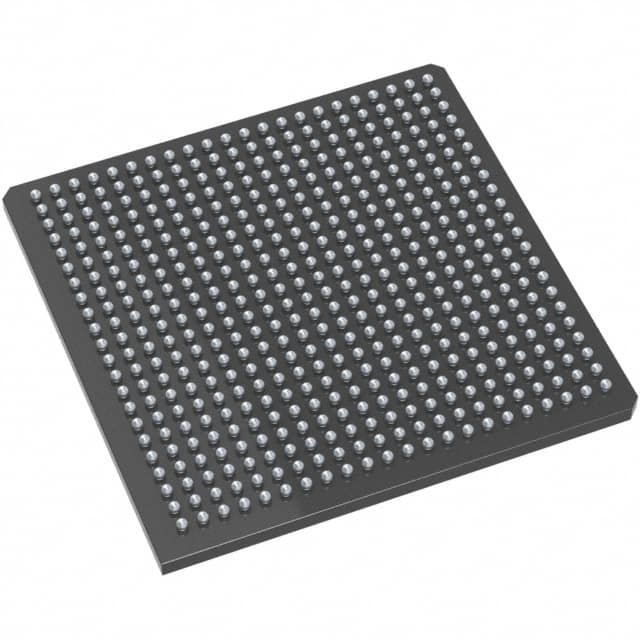Voir les spécifications pour les détails du produit.

P1AFS600-2FG484
Product Overview
Category
P1AFS600-2FG484 belongs to the category of Field Programmable Gate Arrays (FPGAs).
Use
This product is primarily used in digital circuit design and implementation. FPGAs provide a flexible and customizable platform for designing complex digital systems.
Characteristics
- High level of integration
- Reconfigurable architecture
- Parallel processing capabilities
- Low power consumption
- Fast prototyping and development
Package
P1AFS600-2FG484 is packaged in a 484-pin Fine-Pitch Ball Grid Array (FBGA) package.
Essence
The essence of P1AFS600-2FG484 lies in its ability to be programmed and reprogrammed to perform various digital functions, making it highly versatile and adaptable.
Packaging/Quantity
This product is typically sold individually and comes in a standard packaging quantity of one unit per package.
Specifications
- FPGA Family: P1AFS
- Logic Cells: 600
- Package Type: FG484
- Operating Voltage: 3.3V
- Maximum Frequency: 250 MHz
- I/O Pins: 484
- Embedded Memory: 576 Kb
- DSP Slices: 12
- Configuration Memory: Flash-based
Detailed Pin Configuration
The pin configuration of P1AFS600-2FG484 can be found in the manufacturer's datasheet. It provides detailed information on the assignment and functionality of each pin.
Functional Features
- Configurable logic blocks for implementing custom digital circuits
- Dedicated hardware resources for arithmetic operations and signal processing
- On-chip memory for data storage and retrieval
- Flexible I/O interfaces for connecting with external devices
- Clock management resources for synchronization and timing control
Advantages and Disadvantages
Advantages
- Flexibility: FPGAs can be reprogrammed to adapt to changing requirements.
- High performance: FPGAs offer parallel processing capabilities, enabling efficient execution of complex algorithms.
- Fast prototyping: FPGAs allow rapid development and testing of digital designs.
- Low power consumption: Compared to traditional ASICs, FPGAs consume less power.
Disadvantages
- Complexity: Designing for FPGAs requires specialized knowledge and expertise.
- Cost: FPGAs can be more expensive than other programmable logic devices.
- Limited resources: The number of logic cells and memory capacity in an FPGA is finite, which may restrict the complexity of designs.
Working Principles
FPGAs consist of an array of configurable logic blocks interconnected through programmable routing resources. These logic blocks can be programmed to implement desired digital functions using a Hardware Description Language (HDL). Upon configuration, the FPGA operates based on the programmed logic, allowing it to perform various tasks.
Detailed Application Field Plans
P1AFS600-2FG484 finds applications in various fields, including: - Telecommunications - Automotive electronics - Industrial automation - Aerospace and defense - Medical devices - Consumer electronics
In telecommunications, this FPGA can be used for signal processing, protocol implementation, and network optimization. In automotive electronics, it can enable advanced driver assistance systems and infotainment functionalities. In industrial automation, it can facilitate control systems and machine vision applications. In aerospace and defense, it can be utilized for radar and communication systems. In medical devices, it can support imaging and diagnostic equipment. In consumer electronics, it can enhance multimedia processing and gaming experiences.
Detailed and Complete Alternative Models
Some alternative models to P1AFS600-2FG484 include: - P1AFS400-2FG256 - P1AFS800-3CSG324 - P1AFS1200-4FG900
These models offer varying levels of logic capacity, I/O pins, and package options to cater to different design requirements.
In conclusion, P1AFS600-2FG484 is a versatile FPGA that provides high integration, reconfigurability, and parallel processing capabilities. It finds applications in diverse fields and offers advantages such as flexibility, performance, fast prototyping, and low power consumption. However, it also has some disadvantages, including complexity and cost considerations.
Énumérez 10 questions et réponses courantes liées à l'application de P1AFS600-2FG484 dans les solutions techniques
Sure! Here are 10 common questions and answers related to the application of P1AFS600-2FG484 in technical solutions:
Q1: What is P1AFS600-2FG484? A1: P1AFS600-2FG484 is a specific model of Field Programmable Gate Array (FPGA) manufactured by a company called Xilinx.
Q2: What are the key features of P1AFS600-2FG484? A2: Some key features of P1AFS600-2FG484 include 600,000 system gates, 2.5V core voltage, 484-pin Fine-Pitch Ball Grid Array (FBGA) package, and support for various I/O standards.
Q3: What are the typical applications of P1AFS600-2FG484? A3: P1AFS600-2FG484 is commonly used in applications such as telecommunications, networking, industrial automation, automotive electronics, and high-performance computing.
Q4: How can P1AFS600-2FG484 be programmed? A4: P1AFS600-2FG484 can be programmed using Hardware Description Languages (HDLs) like VHDL or Verilog, which describe the desired functionality of the FPGA.
Q5: Can P1AFS600-2FG484 be reprogrammed after deployment? A5: Yes, P1AFS600-2FG484 is a field-programmable device, meaning it can be reprogrammed even after it has been deployed in a system.
Q6: What tools are required to program P1AFS600-2FG484? A6: To program P1AFS600-2FG484, you would typically use Xilinx's Vivado Design Suite, which provides a comprehensive set of tools for FPGA development.
Q7: What are the power requirements for P1AFS600-2FG484? A7: P1AFS600-2FG484 requires a core voltage of 2.5V and has specific power supply recommendations outlined in its datasheet.
Q8: Can P1AFS600-2FG484 interface with other components or devices? A8: Yes, P1AFS600-2FG484 supports various I/O standards, allowing it to interface with other components or devices such as memory modules, sensors, or communication interfaces.
Q9: Are there any limitations or considerations when using P1AFS600-2FG484? A9: Some considerations include power consumption, thermal management, and ensuring proper signal integrity in high-speed designs. The datasheet and application notes provide more detailed information.
Q10: Where can I find additional resources or support for P1AFS600-2FG484? A10: Xilinx's website provides comprehensive documentation, datasheets, application notes, and technical support for P1AFS600-2FG484. You can also refer to online forums or communities for further assistance.

